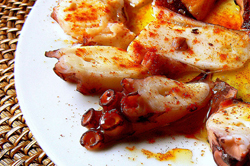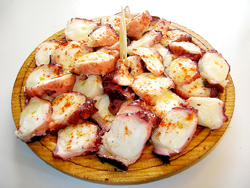
Origin: Galicia

Pulpo a la gallega -Galician style octopus- takes us back many centuries, not because the recipe was the same, but because octopus has been consumed in this autonomous region for longer than we can count.
Octopus was one of the few types of seafood that was transported from the coasts to the interior towns and in fact it was far more appreciated in these towns than near the sea, as those had other products such as lobster, king crab and a great variety of fish.
When America was discovered many products appeared in the Spanish markets, including a fake spice obtained from some crushed red chiles , in Spanish they call it pimentón, in English: paprika.
Not only does paprika give a tempting copperish tinge, but it's also great for preserving food in those time before frozen products and easy land transportation. Now it would be possible to preserve the meat and fish products without problems of rotting, molds or even worse. Eureka
But it wasn't until a few years later that pulpo a la gallega became and actual dish. Some 125 years ago, when muleteers went to cattle fairs, they bought large amounts of octopus and then they'd prepare it with olive oil and paprika. Quite simple.
The name in galician for pulpo a la gallega is "pulpo a feira" (fair style octopus) for a very simple reason. During the cattle fairs the farmers would buy or sell cattle, sell their farm products, etc, and buy groceries such as salt, sugar and other products they didn't have daily access to.
The trip to the town where the fair took place took a long time and most people would stay for lunch or dinner. Those who stayed near the fair venue could eat octopus (as we've mentioned before, it was a very typical dish in fairs).
The "pulpeiras" (specialized in octopus) would cook the animal in copper cauldrons and serve the octopi in wooden plates. It is said that the copper pot gives it an incomparable taste that it's impossible to obtain with any other material
Today the story is a little different, we don't need paprika to preserve food, since we freeze it, but in Galicia, which is still a largely rural region, it's possible to go to cattle fairs and eat pulpo a la gallega and watch the preparation process which has it's own special magic. The good news, it's also possible to prepare it at home.

Ingredients (four portions):
Preparation:
So, pulpo a la gallega doesn't present many problems and it's always tastes great, however, it is said that all food is better when tasted in its source of origin. Should you ever decide to travel to Spain, we suggest you ask the locals for the best Galician style octopus in town.